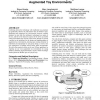Free Online Productivity Tools
i2Speak
i2Symbol
i2OCR
iTex2Img
iWeb2Print
iWeb2Shot
i2Type
iPdf2Split
iPdf2Merge
i2Bopomofo
i2Arabic
i2Style
i2Image
i2PDF
iLatex2Rtf
Sci2ools
ACMDIS
2008
ACM
2008
ACM
Towards guidelines for designing augmented toy environments
Combining interactive technology with traditional toys promises to significantly enhance the educational value of children's play. Designing such augmented toy environments, however, requires designers to take both the traditional, technology-less nature of the toy, and the novel interactive aspects of the newly accessible virtual environment into account. This article attempts to present a unified set of guidelines for the design and implementation of augmented toy environments, drawing upon existing literature in traditional and educational toy and game design, as well as our own experiences in building mixed reality game environments. We also offer practical advice on the use of these guidelines by reporting on our own augmented toy environment for young children, called the Augmented Knight's Castle, which encourages learning about the Middle Ages in a playful way. Categories and Subject Descriptors
Accessible Virtual Environment | ACMDIS 2008 | Augmented Toy Environment | Educational Toy | Human Computer Interaction |
| Added | 12 Oct 2010 |
| Updated | 12 Oct 2010 |
| Type | Conference |
| Year | 2008 |
| Where | ACMDIS |
| Authors | Steve Hinske, Marc Langheinrich, Matthias Lampe |
Comments (0)

